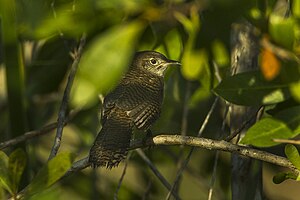Cuban wren
| Cuban wren | ||||||||||||
|---|---|---|---|---|---|---|---|---|---|---|---|---|

Cuban Wren ( Ferminia cerverai ) |
||||||||||||
| Systematics | ||||||||||||
|
||||||||||||
| Scientific name of the genus | ||||||||||||
| Ferminia | ||||||||||||
| Barbour , 1926 | ||||||||||||
| Scientific name of the species | ||||||||||||
| Ferminia cerverai | ||||||||||||
| Barbour, 1926 |
The Cuba Wren or Zapata Wren ( Ferminia cerverai ) is a bird art from the family of wrens (Troglodytidae), which in Cuba in the Zapata Swamp endemic is. The stock is on the IUCN as endangered ( Endangered estimated). The species and genus are monotypical .
features
The Cuban Wren reaches a body length of about 15.5 to 16 cm. The top of the head is blackish brown with fine, lighter brown lines. The side of the face is brownish yellowish-brown with inconspicuous eye stripes . The top is dark brown with a blackish grid pattern, this pattern going laterally over the wing covers and the hand and arm wings. The control feathers are long with fuzzy fluffy ends and black-brown with a fine gray-brown grid pattern. The chin is light whitish yellow-brown, the chest more brown, the flanks darker brown. The rear part of the flanks has distinctive diagonal blackish bands. The thighs and rump are brownish with an obscure dark brown grid pattern. The eyes are clear brown, the upper beak dark brown, the lower beak light yellow-brown. The legs are brownish. Both sexes are similar. Young animals resemble fully grown specimens, but have fine black spots on their throats with unclear blackish brown spots. The flanks show less grid pattern.
Reproduction
Little is known about the breeding biology of the Kuba wren. The first nest was discovered in 1986 and only five have been described so far. The breeding season is probably a little longer. Thus specimens with enlarged testicles were described in January. Eggs were found in late February and nests with well-feathered nestlings were discovered from May 2nd to June 12th. There are probably two broods per year. The nest is built by both sexes and is a ball of cuttings . This is 20 cm tall, the outside diameter 14 cm and the side entrance is about 4.1 to 4.3 cm in size. The inside is lined with feathers and it is built 20 to 70 cm above the cutting edges. The incubation is carried out exclusively by the female. There are no data on breeding and nestling duration. Both sexes accompany the offspring for some time after they have fledged.
Behavior and nutrition
The Cuban wren eats very variably. Most of them are invertebrates like beetles , Schnabelkerfe , grasshoppers , butterflies and spiders , but snails and snail eggs are also part of its diet. Furthermore, frogs or small fringed lizards up to a maximum of approx. 10 cm can belong to its prey. Some vegetarian items , such as lichen or the seeds of Chrysbalanus hicacus, are also among its food sources. It looks for its food in the lower strata of the vegetation, quite often scratching the ground to look for prey.
Vocalizations
The singing of the male Kuba wren consists of a series of four to seven gurgling whistles interspersed with harder chirps, which often last a minute or more. The song of the female is often in a duet with the male, sounds simpler. This sounds like an extended series of warning calls that sound like aschut-schut-schut-schut-schurr . In addition, low, rough schut schut or schurr-schurr tones etc. belong to his repertoire.
distribution and habitat
The Cuban Wren is very limited in savannah-like swamps, in which blades of the species Cladium jamaicense and Typha dominguensis dominate. There are scattered bushes in the habitat that serve as a singing platform. The water level varies, with standing water in the rainy season, but completely without in the dry season.
migration
The Cuban Wren is a resident bird .
Etymology and history of research
The first description of the Kubaz wren was in 1926 by Thomas Barbour under the scientific name Ferminia cerverai . The type specimen was collected by Fermín Zanón Cervera (1875–1944). With the species Barbour introduced the genus Ferminia, which was new to science . Both the genus and the species name are dedicated to its collector.
literature
- Donald Kroodsma , David Brewer in: Josep del Hoyo , Andrew Elliott, Jordi Sargatal , David A. Christie , Eduardo de Juana: Zapata Wren (Ferminia cerverai) in Handbook of the Birds of the World Alive . Lynx Edicions, Barcelona.
- James A. Jobling: Helm Dictionary of Scientific Bird Names . Christopher Helm, London 2010, ISBN 978-1-4081-2501-4 .
- Thomas Barbour: A remarkable new Bird from Cuba (Troglodytidae) . In: Proceedings of the New England Zoological Club . tape 9 , 1926, ISSN 0749-8934 , p. 73-75 .
Web links
- Ferminia cerverai inthe IUCN Red List of Threatened Species 2019.3. Listed by: BirdLife International, 2016. Retrieved January 26, 2020.
- BirdLife International: Species Factsheet - Zapata Wren ( Ferminia cerverai ) . Retrieved January 26, 2020.
- Videos, photos and sound recordings of Zapata Wren (Ferminia cerverai) in the Internet Bird Collection
- Cuban Wren ( Ferminia cerverai ) at Avibase; accessed on January 26, 2020.
- Ferminia cerverai in the Integrated Taxonomic Information System (ITIS). Retrieved January 26, 2020.
- xeno-canto: sound recordings - Cuban wren ( Ferminia cerverai )
- Zapata Wren (Ferminia cerverai) in the Encyclopedia of Life . Retrieved January 26, 2020 (English).
